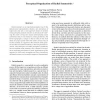Free Online Productivity Tools
i2Speak
i2Symbol
i2OCR
iTex2Img
iWeb2Print
iWeb2Shot
i2Type
iPdf2Split
iPdf2Merge
i2Bopomofo
i2Arabic
i2Style
i2Image
i2PDF
iLatex2Rtf
Sci2ools
CVPR
2004
IEEE
2004
IEEE
Perceptual Organization of Radial Symmetries
Radial symmetry is an important perceptual cue for the feature-based representation, fixation, and description of large-scale data sets. A new approach based on iterative voting along the gradient direction is introduced for inferring the center of mass for objects demonstrating radial symmetries that are not limited to convex geometries. The kernel topography is unique in that it votes for the most likely set of grid points where the center of mass may be located. Initially, it is applied in the direction of the gradient and then reoriented iteratively in the most probable direction. This technique can detect perceptual symmetries, has an excellent noise immunity, and is shown to be tolerant to moderate perturbation in scale. Applications of this approach to blobs with incomplete and noisy boundaries, multimedia scenes, and scientific images are demonstrated.
Computer Vision | CVPR 2004 | Gradient Direction | Important Perceptual Cue | Perceptual Symmetries | Probable Direction | Radial Symmetries |
| Added | 12 Oct 2009 |
| Updated | 12 Oct 2009 |
| Type | Conference |
| Year | 2004 |
| Where | CVPR |
| Authors | Qing Yang, Bahram Parvin |
Comments (0)

